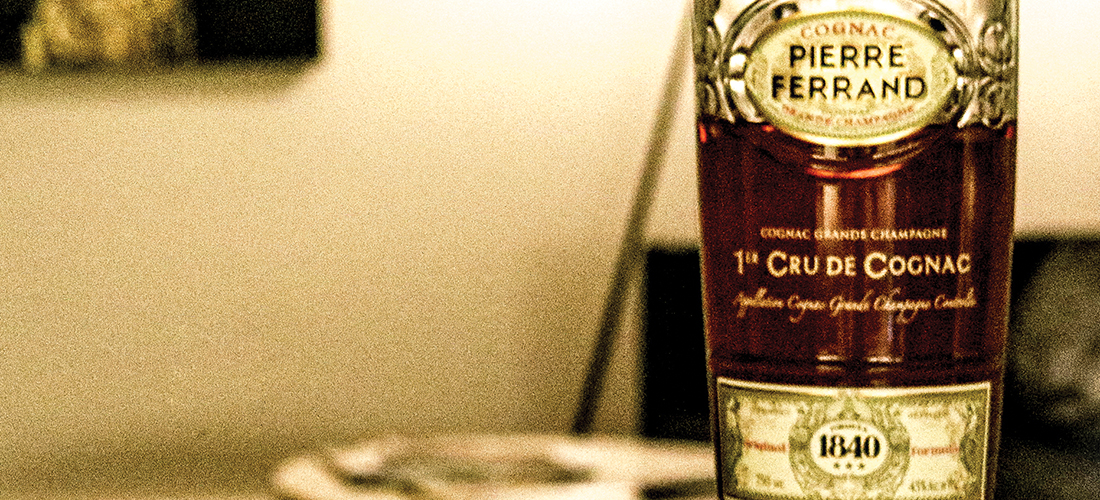
In the Mix
Pierre Ferrand 1840 shines
By Tony Cross
My introduction to cognac happened in the late summer of 2003. I had my first “front of the house” job at an intimate, independent French restaurant. It was small, and so was the staff; I was one of two servers. The owner, Raymond, was the chef, and his partner, Alan, was the sous-chef. Raymond’s wife, Ginette, ran everything up front. I began working there after they had been established for 13 years.
La Terrace was one of a kind. Usually on Saturday evenings, after all of the guests had retired to their homes, and the closing duties were finished, Raymond and Alan would sit at one of the two large round tables in the dining room, enjoying a snifter of Rémy Martin cognac. I remember Raymond explaining to me how cognac is a digestif, a beverage (usually alcoholic) that helps you digest your food. He let me try it, and I’m sure I just shrugged it off. “What do you know? American punk.”
It was a mild rebuke, meant in the nicest way possible. Really. And he was right — all I cared about at the time was drinks, girls, and rock ’n’ roll. Maybe not much has changed.
These days you can find a much wider variety of brandy on the shelves. Brandy is any spirit that’s distilled from juice. Pisco, armagnac and cognac are a few examples. Cognac is produced in the Cognac region of France, and there are six regions, or appellations, where the grapes are grown. The grapes are fermented after being picked and then double distilled in copper pots. The “eau de vie” is then aged in oak barrels.
Cognac is classified in three different categories:
VS (Very Special/Superior): Aged for at least two years in oak casks.
VSOP (Very Special/Superior Old Pale): Aged for at least four years in oak casks.
XO (Extra Old): Aged for at least six years in oak casks.
I’m not an aficionado by any means, so I’m not going to go down a list of cognacs and the differences/similarities in them. I will, however, recommend a great cognac for mixing cocktails. Pierre Ferrand 1840 Cognac is one of the most accessible and versatile cognacs on the market. At 90 proof, it’s great in mixed drinks. It has more of a backbone than Hennessey or Rémy. And don’t get me wrong, I love Rémy Martin.
I became aware of Pierre Ferrand five or six years ago, when I picked up Death & Company: Modern Classic Cocktails, by David Kaplan, Nick Fauchald and Alex Day (still one of the best cocktail books ever put into print IMO). “The Sazerac cocktail was originally made with cognac, until the European phylloxera epidemic in the late 1800s wiped out grape production and bartenders switched to rye,” they write, and go on to suggest using the 1840. One of the finest appellations in Cognac is Grande Champagne, and that’s where the Ferrand estate is located. Ferrand only produces Grand Champagne cognacs (which basically means they only use grapes grown from the soils of that appellation).
If you’re not into making cocktails, you can definitely enjoy this neat. I do. I purchased a bottle the other week, and as you’ll see in the picture above, what’s missing was enjoyed straight. It’s velvety and rich. I picked up notes of pear, lemon and spice; it has a pretty long finish. I don’t think this cognac was designed to be enjoyed neat, but it holds up quite nicely. The place it really shines is in cocktails, like the Sazerac. Some bartenders do equal parts cognac and rye — that’s probably my favorite build. I’ll leave you with the classic Sidecar cocktail recipe from the Death & Co. book.
Sidecar
2 ounces Pierre Ferrand 1840 Cognac
1/2 ounce Cointreau
3/4 ounce lemon juice
1/4 ounce cane sugar simple syrup
Garnish: 1 orange twist
Shake all ingredients with ice, then strain into a coupe. Garnish with the orange twist. PS
Tony Cross is a bartender (well, ex-bartender) who runs cocktail catering company Reverie Cocktails in Southern Pines.





